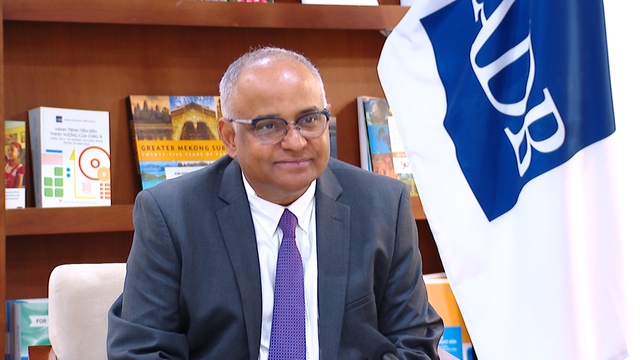FDI inflows to Viet Nam to remain robust in 2025: ADB Country Director
VGP - Foreign direct investment (FDI) inflows to Viet Nam will remain robust in 2025. The country has benefited significantly from its FDI performance, both in accessing the global market and upgrading its productive capabilities.

Asian Development Bank (ADB) Country Director for Viet Nam Shantanu Chakraborty - Photo: VGP/Van Cuong
Asian Development Bank (ADB) Country Director for Viet Nam Shantanu Chakraborty made that above statement in his recent interview with VGP.
Chakraborty said, Viet Nam has indeed performed well on FDI performance in 2024. Total registered FDI into Viet Nam in 2024 reached US$38.23 billion. Disbursed FDI hit a record US$25.35 billion, up 9.4 percent from 2023 and the highest ever recorded.
This is very much positive in the overall context of declining global FDI, higher flows into developed countries and less to developing countries. There is continued momentum of overall higher FDI flows into the Southeast Asia region, including Viet Nam, as part of the ongoing shifts of supply chain reconfigurations in response to geopolitical dynamics, he shared.
While the strong 2024 performance is encouraging, a slight decrease indicated that investment flows into Viet Nam's economy are facing risks of the uncertain global environment. New registered capital slightly declined, although increases of existing FDI projects grew higher, continuing positive contribution to economic growth.
The majority of FDI inflows are concentrated in manufacturing and real estate sectors. While this is strengthening Viet Nam's export position and supporting some domestic segments, there is also a need to diversify FDI attraction to a broader range of economic activities, especially in infrastructure.
Looking ahead, Viet Nam has the opportunity to become a key component in the global technology supply chain, thanks to the gradual completion of legal frameworks that enhance the country's competitiveness and attract multinational corporations. However, uncertainty in the global trading environment and possible protectionist measures may cause further diversion or slowing down of FDI flows.
According to the ADB Country Director, the key sectors that Viet Nam could focus on attracting FDI include high-tech manufacturing, green and renewable energy, the digital economy, agriculture and food processing, as well as healthcare and pharmaceuticals.
These industries align with global megatrends such as green energy, digital transformation, and high-tech manufacturing, ensuring that Viet Nam remains competitive in a rapidly evolving global economy. At the same time, they contribute to reducing reliance on low-tech manufacturing and traditional agriculture, fostering a more balanced and resilient economic structure.
Recently, specialized task forces have been established to directly negotiate and support major corporations like Nvidia and SK in entering the country. Viet Nam is also formulating a strategy to develop a high-quality workforce at competitive costs for high-tech manufacturing. This is a positive sign for further attracting higher-value FDI, he underlined.
With recent reforms and the renewed drive for more ambitious growth targets, Viet Nam could improve its FDI promotion strategy to also attract significantly more investments in infrastructure sectors beyond renewable energy, as well as in high-value services including finance. These will contribute to longer-term improvement of productivity and competitiveness to maintain Viet Nam's FDI attractiveness, noted Chakraborty.
Asian Development Bank (ADB) Country Director for Viet Nam Shantanu Chakraborty talks about Viet Nam's FDI attraction in 2024
Solutions for Viet Nam to attract higher-value FDI
The ADB Country Director highlighted significant efforts of the Vietnamese government to attract FDI in high-tech and sustainable industries, including advanced technologies, clean energy, and environmentally friendly sectors.
Recent incoming FDI are concentrating in manufacturing, although value addition remains limited (about 10 percent for electronics and 5 percent for semiconductors). While this is understandable as the country is still in early stages of technological upgrading, it is important to focus on raising value addition in high-value sectors as well. The government could strengthen their efforts in the following areas:
First, investment promotion strategies. Viet Nam should make a deliberate shift in targeting and approving projects from quantity-focused to quality-focused investment attraction, particularly in priority sectors like high-tech manufacturing, logistics, and renewable energy. This includes conducting a thorough review of existing investment incentives to ensure they effectively target quality investments rather than just volume.
Second, improving efficiency in doing business. This requires enhancing the business ecosystem, from logistics to support services and industries. Infrastructure development remains critical and needs to be accelerated upfront, with priority for climate-resilient infrastructure investments to address current gaps while preparing for future needs to align with global sustainability trends. Additionally, deepening financial markets and expanding long-term capital financing options are essential for attracting sustained investment in capital-intensive sectors like technology and renewable energy.
Third, human capital development is critical. The government should provide supportive schemes for targeted upskilling programs specifically focused on emerging sectors like AI, fintech, and the broader digital economy. This could incentivize businesses to undertake skills development plan to address the current skilled labor shortage, which is a significant barrier to high-value FDI. Such schemes can further strengthen the partnerships of the industries with training and research institutions to be more effective.
Forth, strengthening linkages with domestic business is crucial. An important factor to raise value addition in international supply chains includes policies that foster closer integration between foreign investors and local enterprises. This includes developing programs to help domestic firms benefit from FDI spillovers and supporting their advancement up the value chain. Improving local supply chain integration is particularly important for creating a more attractive ecosystem for sophisticated investors.
Last but not least, innovation and creativity promotion. In addition to fundamental aspects of FDI attractiveness mentioned above, the global technology market has been innovating at ever fast pace, making it a key element of competitiveness. The government has initiated efforts to promote innovation and creativity and can further enhance them with both foreign and domestic enterprises. This will be crucial for maintaining competitiveness in these sectors.
With the ambitious targets of becoming high-income country by 2045, FDI is an important policy tool for the country in transforming its economic structure and productivity, stated the ADB Country Director.
In the context of heightened competition for FDI in Asia, Viet Nam needs to maintain and enhance its FDI attractiveness to achieve its strategic objectives. It is therefore crucial that Viet Nam continue maintaining macroeconomic stability, strengthening the business environment, and especially ensuring policy enforcement and certainty, he suggested.
As of the end of 2024, the country has 42,002 active projects with a total registered capital of nearly US$502.8 billion. The cumulative capital disbursed from foreign direct investment projects was estimated to reach nearly US$322.5 billion, accounting for 64.1 percent of the total active registered investment capital, reported the Foreign Investment Agency, under the Ministry of Planning and Investment.
South Korea took the lead among 147 nations and territories investing in Viet Nam with over US$92 billion. Singapore ranked second with US$83.13 billion.
Three localities have received the largest FDI namely Ho Chi Minh City (US$59 billion), Binh Duong (US$42.48 billion) and Ha Noi (US$42.34 billion)./.
